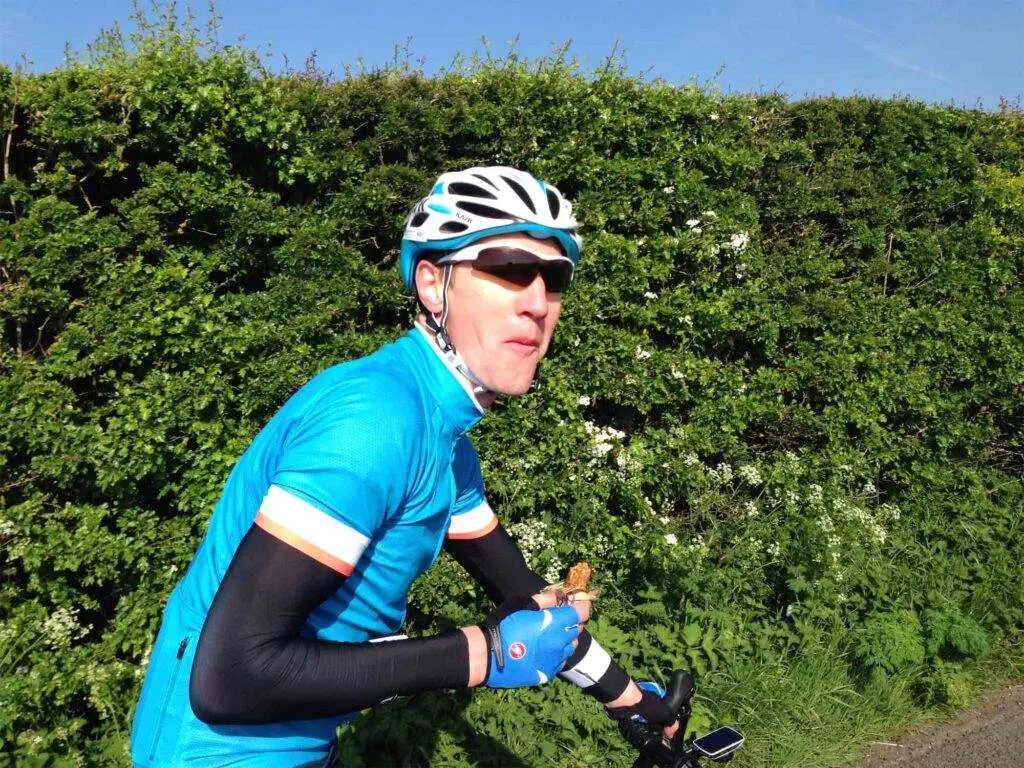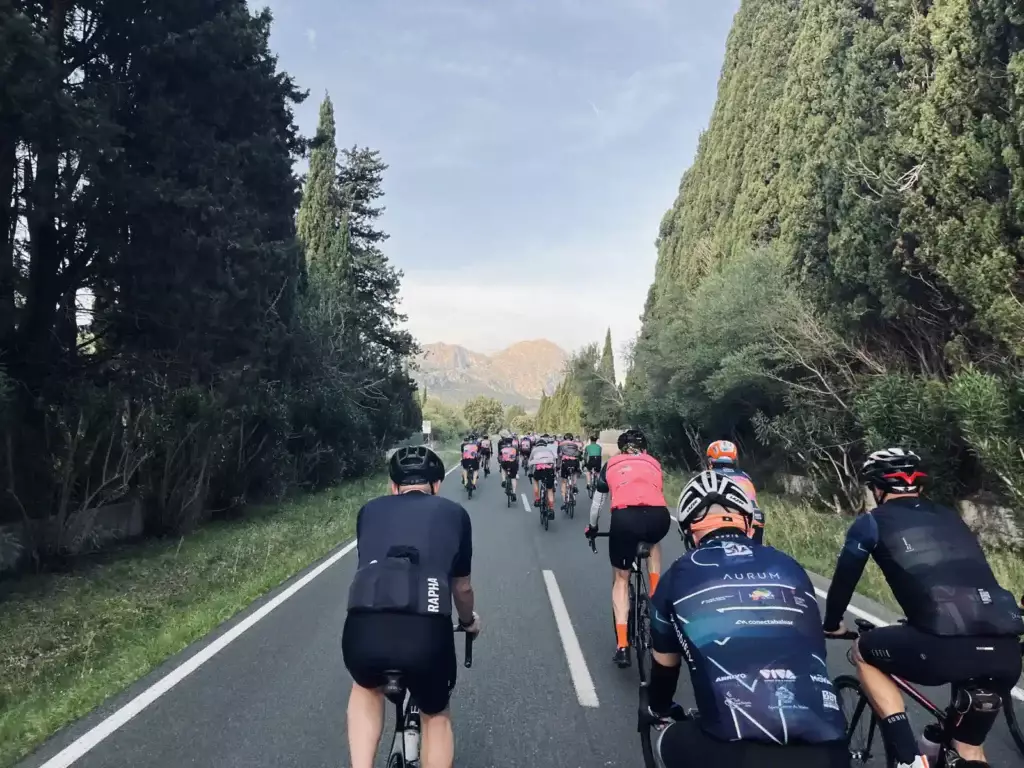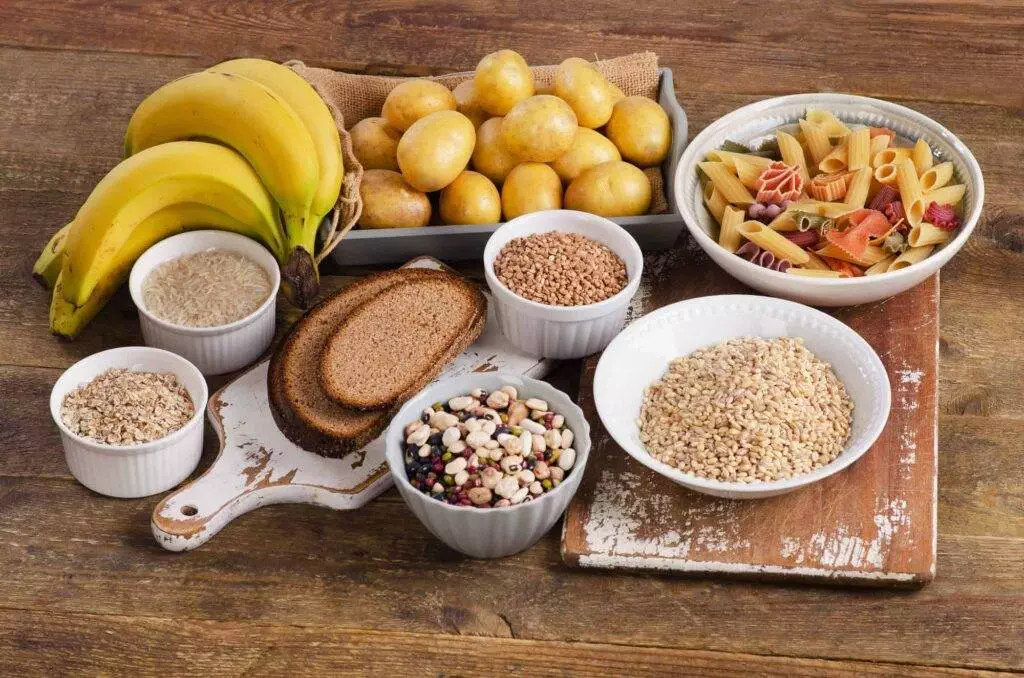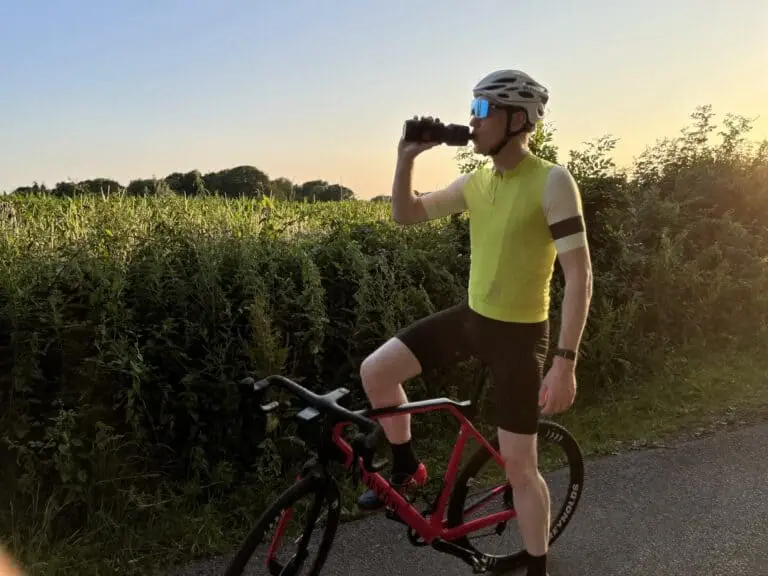Many of us focus on stamina, muscle development, and speed when we train for cycling.
The thought of a proper nutrition plan never even crosses our minds (except if we want to lose weight).
But, what you eat and drink during the training phase, as well as snacks during a race, is so important for your overall performance.
Our cycling nutrition guide will cover everything you could possibly want to know about how to improve your cycling performance through a successful nutrition strategy.
This will include the most important nutrients, helpful tips on hydration, and how to use your diet to your benefit before, during, and after being on the bike.
Key Takeaways
- Carbs, protein, and healthy fat are key for cyclists.
- It is important that you remain hydrated during your workouts.
- A nutrition plan comes down to when you eat, and how much you eat.
- Make sure you eat nutritious food before, during, and after cycling.
- Supplements can help boost your performance.

The Importance of Cycling Nutrition
When you think of nutrition, you probably think of weight loss diets or perhaps diets to help you bulk up. But, food plays a much more important role – it’s a key factor in your overall performance.
The food you eat provides your body with energy in the form of calories. Different foods will provide different amounts of energy, for different durations. For example, a sugary treat will give you a quick burst of energy, but that will also quickly drop your energy levels back down.
Other food, like carbs, can provide you with more sustained energy for longer rides.
Your daily calorie consumption needs will depend on how tough your training sessions are, your metabolic rate, your age, and your gender. On average, a cyclist must consume between 2,000 and 7,000 kcal each day when training.

Key Nutrients for Cyclists: Carbohydrates, Protein, and Healthy Fats
Now that you know more or less how many calories you need to consume, what exactly should you eat to get there?
Macronutrients for cyclists are divided into three groups: carbohydrates, proteins, and healthy fats. These three macros are crucial to help cyclists reach peak performance.
Carbs
Ever heard of carb-loading? That is when athletes start consuming carbohydrate-rich foods in the week or so leading up to race day.
The reason for this is that carbohydrates provide energy to the body. Carbs are converted to glucose, and when glucose is not used, it is converted to glycogen which is stored in the muscles, liver, and blood.
Your body can then tap into these muscle glycogen stores when going for longer rides or doing intense workouts.
You tend to deplete the stores with strenuous exercise, which is why eating carbs daily is so important. By consuming carbs, you replenish the glycogen and also increase the blood glucose levels, which provide you with ongoing energy.
Carbs can be found in:
- Wholegrain pasta
- Rice or quinoa
- Muesli
- Potatoes
- Sweet potatoes
- Oatmeal
- A store-bought carbohydrate drink
Just watch your carbohydrate intake on race day as a big meal filled with carbs can make you feel slightly sluggish at first.

Protein
Protein is the building block of our muscles and connective tissues, so it should come as no surprise that we need to eat protein if we want to perform well.
When you combine protein and carbohydrate intake, you are ensuring your muscles have enough “food” to keep going. Protein consumption will help with recovery after exercise, and reduce muscle soreness from a tough session on the bike.
Protein also has the ability to increase the energy stores in your body, making it the ideal macro for endurance athletes.
Lots of food contains protein, but we won’t recommend that you snack down on a hearty burger right before your ride. Here are some of the best protein sources for cyclists:
- Lean meat like chicken or turkey
- Eggs (specifically egg whites)
- Tofu
- Legumes and beans
- Low-fat dairy
- Quinoa
Personally, maintaining a consistent protein intake has been a significant challenge. However, with some planning and making the right dietary choices, I’ve found it to be a game changer for training.
Fats
Fats don’t have the best reputation. People associate fatty foods with an increase in body weight and an overall unhealthy diet.
But, there are some good fats out there!
Unsaturated fats like Omega 3 and 6 are especially beneficial.
Fats are actually better than carbs at providing energy for the body when resting or going for a low-intensity exercise session.
Some healthy fats can be found in:
- Olive oil
- Canola oil
- Avocado
- Nuts and seeds
Hydration: The Importance of Proper Hydration for Cyclists
We have all worked up a sweat while out on the bike. And sure, sweat has its benefits – especially once that refreshing breeze blows over you and cools you down.
But when we sweat, we lose water and salt, which can lead to dehydration. That is why proper hydration should form part of any cycling nutrition plan.
Cyclists should aim to drink about 0.5 gallons of water daily and should increase that amount if they have a tough exercise session ahead of them.
Drinking only water is fine, but you ideally want to increase your electrolyte uptake before a long ride or race day as well.
This can be done by drinking sports drinks or adding an electrolyte drink mix to your water bottle.
Timing and Portion Sizes: The Importance of Eating Balanced Meals and Snacks Before and After Rides
There are many websites that will provide you with an example cycling nutrition plan, detailing all the different foods you need to eat. While that is fine and good, a lot of your cycling diet comes down to timing.
When you eat is almost as important as what you eat!
Let’s look at some of the best tips for eating before and after training.
Eating before cycling
Food is fuel, and just as you need to put fuel in your car before going for a drive, you also need to fuel your body before exercising.
The best way to fuel your body for a ride is to ensure you have enough glycogen in your stores. This is done by eating regular, healthy meals throughout your training phase.
Eating carbs in smaller portions, but consistently, is especially important. It means your stores will remain topped up, but you won’t feel heavy or have any gastrointestinal distress from large, carb-heavy meals.
Regular meals that contain whole grains and other foods with higher fiber content, as well as healthy fats and proteins, will make sure you are primed and ready for cycling.
When it comes to race day or an endurance ride, you want to eat a carbohydrate-filled meal 3 to 4 hours beforehand. You can snack on fruits and green vegetables 20 to 40 minutes before the event. And remember plenty of fluids!
This is just a general guideline but will help ensure that you have sustained energy for the big race.
Eating after cycling
Eating after training sessions or a race is as important as fueling your body beforehand.
This is because you need to replenish your glycogen stores and help your body to recover from the ride.
Post-ride nutrition is the most vital in the 30 minutes after your ride. Your body is primed and ready to replenish your muscle glycogen stores and rebuilt any damaged or injured muscles.
Carbs and protein after a race are critical. Carbohydrates will begin to restock the glycogen stores, and protein will help to rebuild the muscles.
Endurance athletes will often be seen drinking post-workout supplements or protein shakes to recover. These do work, but a good meal with healthy, fresh food can go a long way too.
If you can’t afford an expensive recovery shake, a glass of chocolate milk is a great replacement. It contains protein, carbs, and sugar and helps to rehydrate you.
There is a golden ratio to post-ride recovery: 3:1.
That means 3 parts carbs to 1 part protein.
Keep that in mind when you are reading the labels of your shakes or preparing a hearty post-ride meal and you should be a-okay!

Tips for Fueling Your Ride: Practical Advice for Optimizing Performance and Recovery
This can all feel a bit overwhelming – carbs, glucose, protein, fats – there is a lot to take in.
We’ve broken down all these detailed instructions into helpful, practical tips to get you started on your road to being your best cycling self.
Disclaimer
I am not a qualified trainer or nutritionist. The dietary information listed is based on my personal experience. If you’re unsure about any dietary requirements, please consult a certified professional for guidance.
How many calories to eat
The first thing you need to figure out is exactly how many calories you need to eat. You can do this by using freely available online calorie calculators.
For example, a 40-year-old male, standing 5’11” tall and weighing 180 pounds, doing intense daily exercise, needs to consume 2,989 calories a day to maintain his weight.
How many carbs to eat
The exact amount of carbs you need to eat will also depend on your age, gender, body weight, activity level, and goals. A good starting point is to eat about 60-80 grams during a ride. As your intensity increases, so will your carb intake.
As we mentioned, this is just a guideline. The way you approach carb-loading or snacking during your ride will come down to what is right for you. If you eat too many carbs, you’ll end up with stomach problems like cramps, gas, and diarrhea.
Too few carbs and you’ll be struggling for energy and feeling depleted while exercising. It comes down to trying different strategies and determining what feels right for your body.
Eating during a ride
Eating while on the bike is very important if you plan on riding for longer than an hour.
If you’re doing high-intensity bursts or intervals, then you should get quick-acting nutrients into your body. Energy gels, energy drinks, and other simple sugars are nifty in these instances.
For longer, slower, or less intense rides, you can eat some more complex carbs like a PB&J sandwich, a banana, or a handful of nuts.
Sometimes you might notice that no matter what you eat (or don’t eat) during a ride, you’ll still feel completely depleted at the end. This is because your body can only do so much while pedaling, and highlights the importance of pre- and post-ride cycling nutrition.
Below, we’ve provided some tips on what to eat for longer and shorter rides:
Eating for long rides
Before you get started, make sure you have a nutrition plan in place and know exactly what to take with you.
You want a sustained supply of carbs and a little bit of protein, as well as plenty of fluids to keep you hydrated. Try and spread your snacking out across the duration of the ride, and take sips of your chosen liquid every 15 to 20 minutes.
Here are some snacks to take along for the ride:
- Bananas
- Nuts and seeds (specifically flaxseeds)
- Dried fruit
- Peanut butter (or other nut butter) sandwich on wholegrain bread
- Protein bar
- Energy drinks
- Energy gels
Eating for short rides
Rides lasting less than an hour will not really require a lot of food. You could get away with a bottle of water or an electrolyte drink. This is especially true if you have been following a good cycling nutrition plan in your daily life – you should be good to go!
But just because you can go without snacks during a short ride, doesn’t mean you should.
You are still burning through your energy stores, even on shorter training sessions.
You can take the following along on a shorter ride:
- Water
- Electrolytes
- Sports drink
- Energy bars
- Energy gels
You’ll be aiding your recovery process by consuming these products even during a short ride.
Eating after a ride
We’ve already mentioned the importance of cycling nutrition after a workout or long ride. If you eat properly during your ride, it will be less critical, but nonetheless important.
After your ride, you want food that contains a good balance of carbs and protein, as well as some fats and sugars.
Here are some healthy meals you can enjoy after your tough training session:
- Oatmeal with fresh strawberries
- Unsweetened yogurt with nuts, seeds, or muesli
- Dilute fresh fruit juice with water
- Scrambled eggs with wholewheat toast
- Grilled chicken and rice
- Salmon or tuna with fresh veggies
These meals contain slow-release carbs to restore your muscle glycogen as well as protein to help rebuild your painful muscles.
Supplements: The Role of Supplements in Supporting Performance and Recovery
We’ve all been told to eat all our vegetables to make sure we get all the vitamins we need. But sometimes what is found on our plates just isn’t enough.
Enter the mighty supplement.
Supplements come in a lot of different forms and can contain a variety of vitamins and minerals to boost your performance.
Some of the most important vitamins and minerals for cyclists are vitamins A, D, C, B6, B12, and K, and magnesium, iron, calcium, and zinc.
These health boosters can be found in the food we eat – specifically fresh fruit and vegetables. But sometimes we just need that little bit extra to get us where we want to be in terms of performance.
To ensure you don’t develop any deficiency, a multivitamin is a good idea. You can also add a protein shake or pre-workout shake to your training regime. These often contain amino acids, antioxidants, minerals, and vitamins to help you perform your best and aid in recovery after training.
Next Steps: The Importance of Consulting a Healthcare Professional or Sports Nutritionist for Personalised Guidance and Support
We’ve said it once and we’ll say it again: your cycling nutrition plan will depend on your personal circumstances.
Your cycling goals, body type, age, gender, and activity levels will all influence what you need to eat.
For this reason, we recommend that you approach a dietician or sports nutritionist to help you come up with the perfect meal plan to help you perform your best.
FAQs
What are the most important nutrients and minerals for cyclists?
The best minerals, vitamins, and nutrients for serious cyclists include:
- Omega 3 fatty acids
- Iron
- Vitamin D
- Calcium
- Magnesium
What should I eat if I plan on cycling every day?
Frequent cyclists should focus on eating smaller portions of slow-release carbs each day. This includes rice, pasta, wholewheat bread, or quinoa. You should also make sure you get enough protein and healthy fats.
What is the best snack for cyclists?
Bananas! They contain potassium, and carbs and replace any electrolytes that were lost during a training session.
